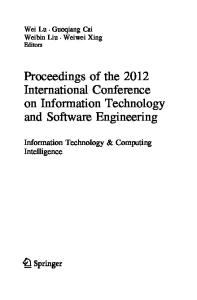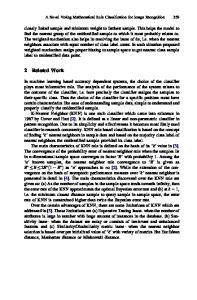Mathematical Classification and Clustering
- PDF / 318,026 Bytes
- 11 Pages / 595 x 842 pts (A4) Page_size
- 20 Downloads / 327 Views
#1997 Operational Research Society Ltd. All rights reserved. 0160-5682/97 $12.00
Book selection Edited by JM Wilson S Rios (ed): Decision Theory and Decision Analysis: Trends and Challenges C Armistead and P Rowland: Managing Business Processes BPR and Beyond JC Oliga: Power, Ideology and Control AC Borthakur and H Choudhury (eds): Probability Models and Statistics. AJ Mehdi Festschrift AI Kibzun and YS Kan: Stochastic Programming Problems with Probability and Quantile Functions LW Friedman: The Simulation Metamodel R Horst and H Tuy: Global Optimization (3rd edition) B Mirkin: Mathematical Classi®cation and Clustering J Dickinson Gibbons: Nonparametric Methods for Quantitative Analysis (3rd edition) L Fortuin, P van Beek and L van Wassenhove (Eds): OR at wORk: Practical experiences of operational research
Decision Theory and Decision Analysis: Trends and Challenges
S Rios (ed) Kluwer Academic Publishers, London, 1996. xv 294 pp. £66.75. ISBN 0 7923 9466 6 Decision analysis and decision theory have expanded substantially over recent years from the chapter on decision making and decision trees in operational research and management science texts to a well developed body of literature (and software) covering both the quantitative and behavioral aspects. This text is a valuable contribution to this body of literature. It is the published outcome of the conference Decision Making: Towards the 21st Century held in June 1993 at the Real Academia de Ciencias de Madrid The text covers nearly 300 pages, produces the work of 36 experts in the area in twenty chapters, and is divided into three sections, Overviews (four chapters), Theory and foundations (seven chapters), and Applications (nine chapters). This is a sound balance because ultimately decision making is about making decisions in the business and organizational world. The four chapters in the overview section are extremely readable, covering the prescriptive orientation of decision making, namely a synthesis of decision analysis, behavioral decision making, and game theory; recent development in utility theory; decision in¯uence diagrams and their uses; and a structured model for approaches in decision making (a pyramid of decision approaches). I felt this part would be
846 847 847 848 849 850 850 852 853 853
of great value to practitioners and to ®nal year undergraduates and MBA students. Part II, Theory and Foundations, containing a set of very strong theoretical papers, will repay very careful study for it is from here that applications will emerge in the future. The areas addressed embrace direct decision making where there is no prior information concerning underlying distributions; the Ellsberg phenomenon; robust decision making, rational comparisons and numerical representations; topological characterizations of posets; and inference in multidimensional Gaussian processes. The ®nal part of the text covers a wide range of applications, including such areas as lotteries, auctions, MCDM in relation to economic analysis, NP-complete job-shop scheduling, mul
Data Loading...











